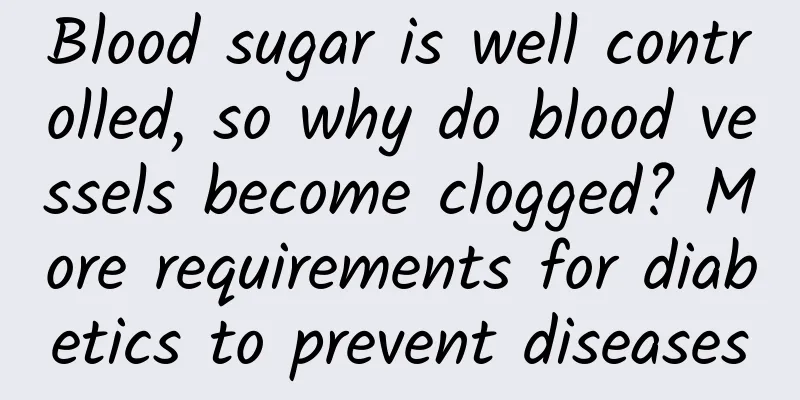Blood sugar is well controlled, so why do blood vessels become clogged? More requirements for diabetics to prevent diseases

|
A diabetic patient in his 60s told Huazi that he went to the hospital for a checkup during the Chinese New Year because he felt chest tightness and shortness of breath. He was found to have two severe stenosis in his coronary arteries. He eventually underwent surgery and two stents were placed to relieve his symptoms. He said that his blood sugar was well controlled, around 5.6mmol/L on a fasting basis, and his glycosylated hemoglobin was around 6%. Why would his blood vessels become blocked? Huazi said that for diabetics, to prevent cardiovascular and cerebrovascular diseases, it is not only necessary to control blood sugar, but also to control blood pressure, blood lipids and other indicators, and the requirements are more stringent. 1. Damage of diabetes to cardiovascular system Through communication, Huazi found that this diabetic patient was a "chronic patient" for many years. He had been suffering from diabetes for seven or eight years. Although he had been taking hypoglycemic drugs, he only seriously controlled his blood sugar after the symptoms of "three more and one less" became obvious in the past one or two years. Huazi said that his blood sugar was well controlled in the past one or two years, but he had obvious symptoms before, which showed that his blood sugar condition was not good for a long time. Uncontrolled high blood sugar will increase oxidative tension, glycosylate various proteins, and cause long-term damage to blood vessels. This is diffuse, causing damage to the vascular endothelium, promoting the formation of atherosclerotic plaques, and leading to vascular stenosis. Therefore, diabetic patients need to control their blood sugar throughout the course of the disease, rather than waiting until symptoms appear to control it. 2. In addition to blood sugar, you should also control blood pressure and blood lipids. High blood sugar and high blood lipids are both metabolic disorders. 70% of diabetics also have high blood lipids. High blood lipids are also a risk factor for atherosclerosis, but the symptoms of high blood lipids are not obvious and are easily overlooked. The indicator for measuring the degree of danger in high blood lipids is the level of low-density lipoprotein cholesterol (LDL-C). For people with diabetes, it is recommended to control the LDL-C level below 2.6mmol/L, preferably below 1.8mmol/L. Diabetic patients also often suffer from hypertension. The blood pressure control target is usually required to be below 140/90 mmHg. However, diabetics have multiple risk factors. In order to better protect the cardiovascular system and kidneys, it is recommended that the blood pressure of diabetics be controlled below 130/80 mmHg. 3. Don’t forget to exercise during hypoglycemic treatment. In addition to controlling the “three highs” of high blood pressure, high blood lipids, and high blood sugar, it is also very important to maintain a healthy lifestyle, including quitting smoking, controlling diet, and exercising regularly. For diabetic patients, while controlling the total calories of their diet, they must also pay attention to exercise. Many obese patients with type 2 diabetes do not have insufficient insulin secretion, but because of too much body fat, the free fatty acids in the blood increase, causing severe insulin resistance. Exercise can increase the insulin receptors on tissue cells and is the most effective way to reduce insulin resistance. Some obese patients with type 2 diabetes can even reverse diabetes through diet control and exercise, reduce the dose of hypoglycemic drugs or stop taking them. 4. Choose hypoglycemic drugs that have a protective effect on the cardiovascular system. Among oral hypoglycemic drugs, traditional metformin, while lowering blood sugar, also has a significant protective effect on the cardiovascular system. "Liptin" hypoglycemic drugs lower blood sugar by promoting the excretion of glucose from urine, while also increasing the excretion of sodium ions and uric acid, producing a hypotensive effect and protecting the cardiovascular system. "Liptin" hypoglycemic drugs produce a hypoglycemic effect by increasing the level of glucagon-like peptide-1 (GLP-1), and can improve circulation and protect the cardiovascular system. Due to individual differences, different diabetic patients have different sensitivities to drugs, and doctors need to evaluate and select appropriate drugs. If blood sugar is high after a meal, acarbose can be added to the meal to delay the absorption of sugary foods. In summary, in addition to paying attention to their blood sugar index, diabetic patients should also pay more attention to blood pressure and blood lipids. The best choice is to control blood pressure below 130/80mmHg and LDL-C below 1.8mmol/L. Hypoglycemic drugs must be used under the guidance of a doctor. If you have any questions about the use of drugs, you should consult a doctor or pharmacist in time. I am pharmacist Huazi, welcome to follow me and share more health knowledge. |
Recommend
Is myopia hereditary?
June 6, 2022 is the 27th National Eye Care Day. S...
Are pubic lice contagious?
Pubic lice is a very common sexually transmitted ...
Smartwatch sales in the global wearable device market will increase significantly by 5% in 2025
In 2025, the global wearable device market will u...
What to do if you have a headache while breastfeeding
Nowadays, everyone advocates exclusive breastfeed...
What is the area between the vagina and anus called?
The part connecting the female vagina and anus is...
Can I wear an IUD during breastfeeding? Can I wear an IUD during breastfeeding?
What we call "inserting an IUD" is also...
The correct method of uterine moxibustion
The uterus is a reproductive organ in the female ...
How to store fresh fruit corn? How to eat fruit corn
There are many ways to eat fruit corn. It can be ...
Is medical abortion at two and a half months considered induced labor?
Although young women today have a more open attit...
Which parts are good for women to use moxibustion
Moxibustion is the most traditional Chinese medic...
Why is there bleeding again two days after the menstrual period?
Generally, normal adult women have menstruation o...
What should girls do if they have lower back pain during menstruation?
Some women experience lower back pain during thei...
It's so wet down there, what's going on?
In real life, many female friends encounter an em...
Fear of cold during early pregnancy
Female pregnancy is a special physiological perio...









